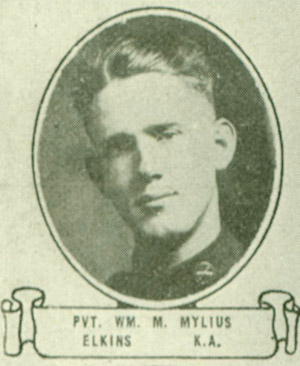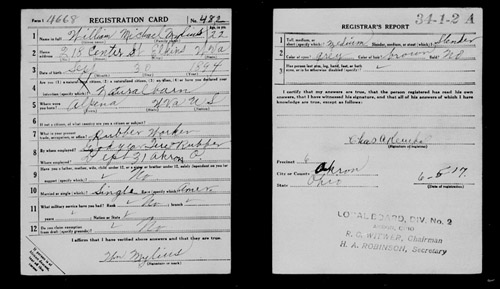

Remember...
William Michael Mylius
1894-1918
"The long hours crept by with leaden feet and sometimes it seemed as if time itself was dead."
Frank Noakes
 |
Remember...William Michael Mylius
|
William Michael Mylius' grandfather, Charles Emil Mylius, was a watchmaker who emigrated from Germany and settled down to a life of farming in the Swiss community of Alpena in Randolph County, West Virginia. William's parents were Charles Francis Mylius and Nancy Emmaline Woodford Mylius. They were married in Randolph County on January 14, 1890. William was born on September 30, 1894, at Alpena. He had an older sister, Amiee (Mrs. Cleveland Wallace Steele, later Mrs. William Green), and two brothers, Charles Woodford and Leslie Clair.
The 1910 Federal Census for the Dry Fork District of Randolph County listed William in the household of his maternal grandparents along with his mother, his sister Amiee, and his younger brother Leslie. William's occupation at that time was shown to be "farm laborer." He had attended Davis and Elkins College prior to being called to military service.
On June 5, 1917, William Michael Mylius registered at Akron, Ohio, for the World War I draft. He was employed then as a rubber worker at the Goodyear Tire and Rubber Company. He indicated that he was single and had no dependents. His registration card shows that he was of medium height and slender build and had grey eyes and brown hair.

Draft registration for William M. Mylius. National Archives and Records Administration
When William entered the U.S. Army, he was assigned to the Medical Detachment of the 11th Infantry, which was part of the 10th Infantry Brigade within the Fifth Army Division. The 11th Infantry Regiment departed on April 24, 1918, for France and joined the 5th Division near Chaumont, France. During the weeks that followed, the 11th participated in major battles, among them the St. Mihiel Offensive between September 12 and September 16. The objective of this battle was fourfold: 1. To deprive the Germans of the St. Mihiel salient; 2. To prevent them from interrupting traffic on the Paris-Nancy Railroad by artillery fire; 3. To free the railroad leading north through St. Mihiel to Verdun; and 4. To provide a base of departure for an attack against the Metz-Sedan Railroad system, vital to the German armies west of Verdun and against the Briey Iron Basin, which was necessary for the production of German armament and munitions. American forces suffered 7,000 casualties during the St. Mihiel Offensive, far fewer than expected.
Army Private William Michael Mylius was killed in action on September 13, 1918, during the St. Mihiel Offensive. He was probably initially buried in a battlefield grave, was later interred in a U.S. cemetery in Europe, but was finally brought home for burial in the United States. At the conclusion of the war, France resisted removing bodies for reburial, but in 1920 the French agreed to the return of American soldiers to the United States. The remains of 46,000 war dead were returned to the U.S. at a cost of over $30 million.
Article prepared by Leon Armentrout
February 2015

West Virginia Archives and History welcomes any additional information that can be provided about these veterans, including photographs, family names, letters and other relevant personal history.